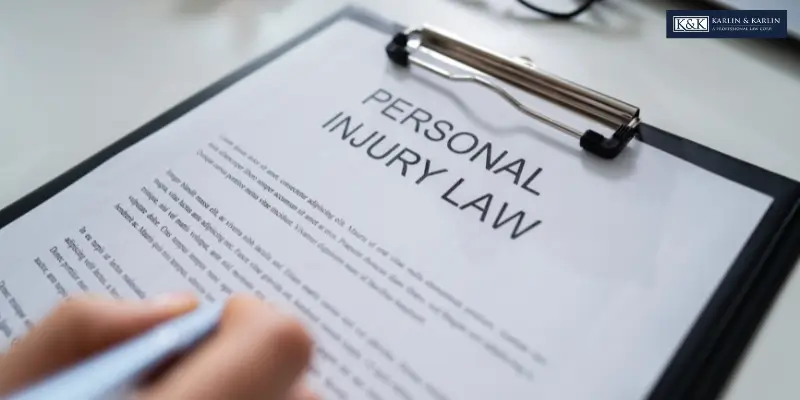California Personal Injury Statute of Limitations
If you have suffered harm due to someone else’s negligence, it is crucial that you comprehend how California handles personal injury claims, including the California personal injury statute of limitations. State statutes set forth criteria for determining compensation and specify when and how a victim may bring a claim. When a statute of limitations is ignored or forgotten, it can have immense consequences on your claim.

The Statute of Limitations for Personal Injury Claims in California
The amount of time you have after being harmed to file a case in civil court varies. The statute of limitations differs according to the kind of case you are pursuing. According to California’s statute of limitations for personal injuries, you have two years from the date of the incident to bring a claim against the parties you feel are legally liable for your injuries. The “clock” usually begins to run on the day of the incident or accident that resulted in your injury.
If you don’t file your case within the time frame, it’s likely that the court will decline to hear your case, which will take away your ability to pursue legal action to make up for the harm you’ve endured. This also takes away your ability to receive damages.
Extensions to California’s Statute of Limitations
Even though statutes of limitations are strictly enforced, plaintiffs may occasionally be given more time if certain circumstances occur. For example:
- If a victim is under the age of 18, the clock on their statute of limitations will not begin until they are 18 years old.
- The clock begins to run when the sufferer discovers—or should have discovered—their injuries in specific situations when they were not aware of them.
In personal injury cases, victims typically become aware of their injuries shortly after the incident. Therefore, this last situation is less prevalent. But in other cases, like asbestos exposure or medical misconduct, the harm may not show symptoms for years.
How the Statute of Limitations in California May Impact an Insurance Claim
The statute of limitations in California relates to litigation, not insurance claims. When handling insurance claims, it’s still advisable to keep the statute of limitations in mind. It’s most advantageous to file your injury-related insurance claim as soon as possible following the accident.
Avoiding delays in the claims procedure can help ensure that you have enough time, should the need arise, to launch a claim. Maintaining your right to go to court can provide you additional negotiating power during settlement talks, even if you are certain that your insurance claim will be settled fairly.
How to File a California Personal Injury Case
There are various processes involved in bringing up a personal injury case in California. Firstly, you must submit a complaint and request a summons from the court. Your claims against the defendant must be outlined in the complaint, along with a demand for payment for your losses and associated injuries.
The defendant is then notified of the claim via the summons. Copies of the complaint and summons must be served to the defendant, which is your obligation. This means your attorney or other state-approved individuals must serve the defendant with your claim.
One of California’s “superior” (trial) courts, which preside over all civil proceedings in the state, will most likely receive your claim. Generally, you file in the county courts where the defendant resides or where the injury happened. Federal courts may hear personal injury claims. However, this normally happens only when the plaintiff and defendant are from different states, and the requested damages exceed a certain amount of money.
A website maintained by the courts in California provides guidance and recommendations to anyone who is thinking about representing themselves in court, along with forms such as a summons and a personal injury complaint. It’s important to consider whether filing a claim makes sense in your particular circumstances and whether handling your case on your own would suffice or if you’d be better off working with an attorney.
Filing Claims Against Government Entities
Because of the regulations outlined in the California Tort Claims Act, it might be difficult to file a claim against government entities or personnel in California. For instance, instead of the customary two-year statute of limitations for personal injury cases, plaintiffs have only six months to pursue an injury claim against a government agency or employee.
Like other states and the federal government, California also offers its agencies and employees extensive immunity from litigation, so even if they were to be held accountable for your injuries, you would not be able to file a claim against them. In such circumstances, it is strongly advised that you speak with an attorney before pursuing your case.
FAQs About California Personal Injury Statute of Limitations
What Is the Time Limit to File a Claim Against a Party in California?
In California, the general statute of limitations for filing a personal injury claim is two years from the date of the incident. There are exceptions, however, to this rule. For example, this statute could be extended if the person filing was a minor at the time of the incident. Failing to file within this period usually results in losing the right to file a claim as well as the right to receive damages.
What Is the 3-Year Statute of Limitations in California?
A three-year statute of limitations applies in California for property damage claims. This means you have three years from the date of the incident that caused the damage to file a claim against the negligent party. This gives you time to receive and assess any repairs needed before filing a claim.
Are There Laws in California That Limit Damages for a Personal Injury?
Yes, California limits non-economic damages in specific cases, such as medical malpractice claims and car accidents involving uninsured drivers. For instance, the Medical Injury Compensation Reform Act (MICRA) caps non-economic damages in medical malpractice cases. It is important that you speak with an personal injury attorney to know if there are any caps that apply to your specific situation.
What Happens If You Miss the Statute of Limitations in California?
If you miss the statute of limitations in California, the court will likely dismiss your case, and you’ll lose the right to pursue legal action for your injuries. This highlights the importance of acting promptly when considering a claim. Even if you feel that you have a lot of time, it is recommended to file as soon as possible to account for any possible delays.
Contact Karlin & Karlin Today
If you have been injured due to the negligence of another person or entity, you may be entitled to compensation for your damages. Karlin & Karlin can help. Contact us today for more information.
Recent Posts
Looking For Legal Assistance?
Request a Free Consultation
Fields Marked With An “*” Are Required
We Do have live operators 24/7 (English & Spanish)


![California Immigration Laws: What’s New and How They Impact You [2025 Updated]](https://www.karlaw.com/wp-content/uploads/2025/04/guidance-on-citizenship-CA-NV-78x89.webp)



